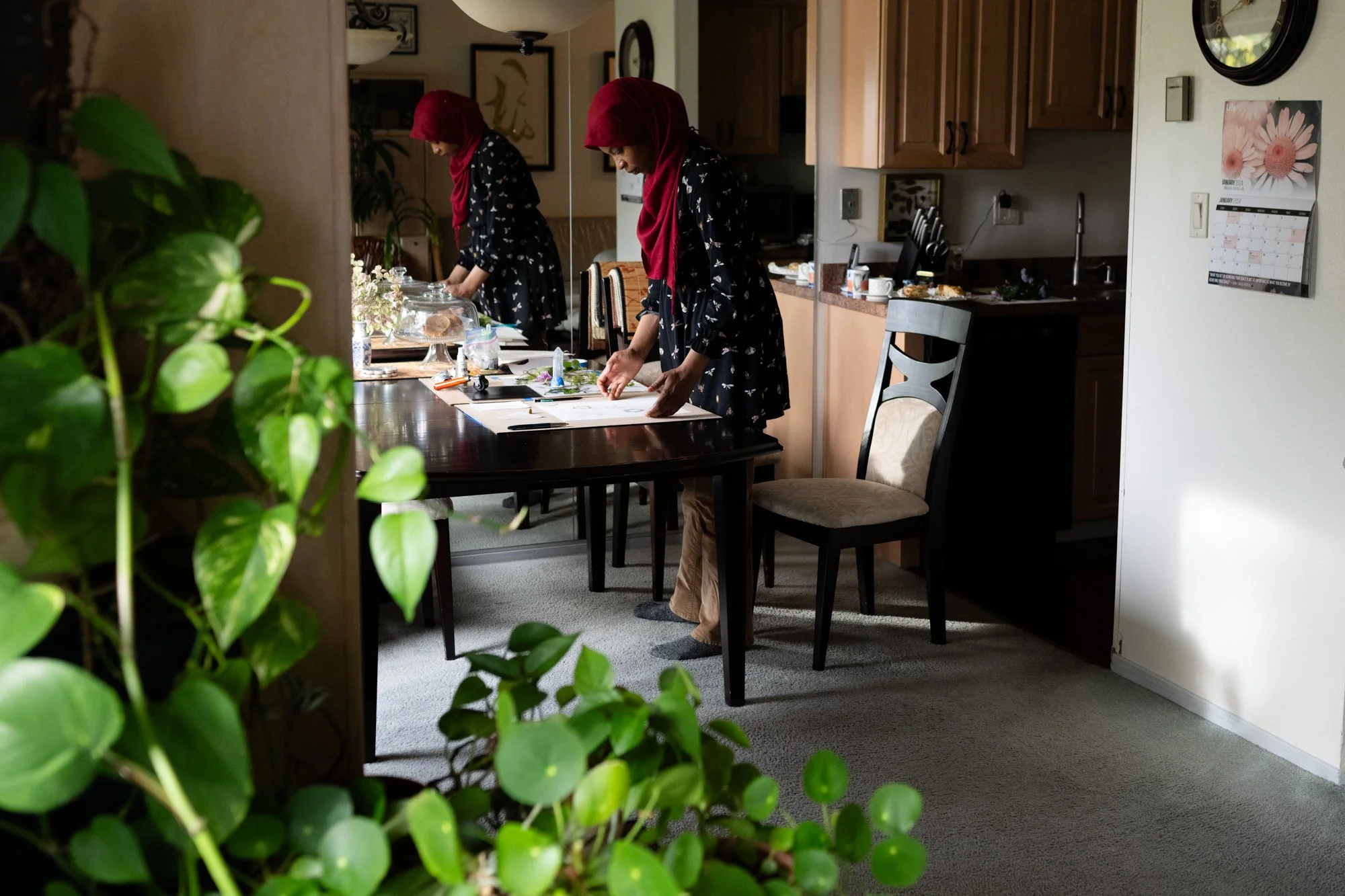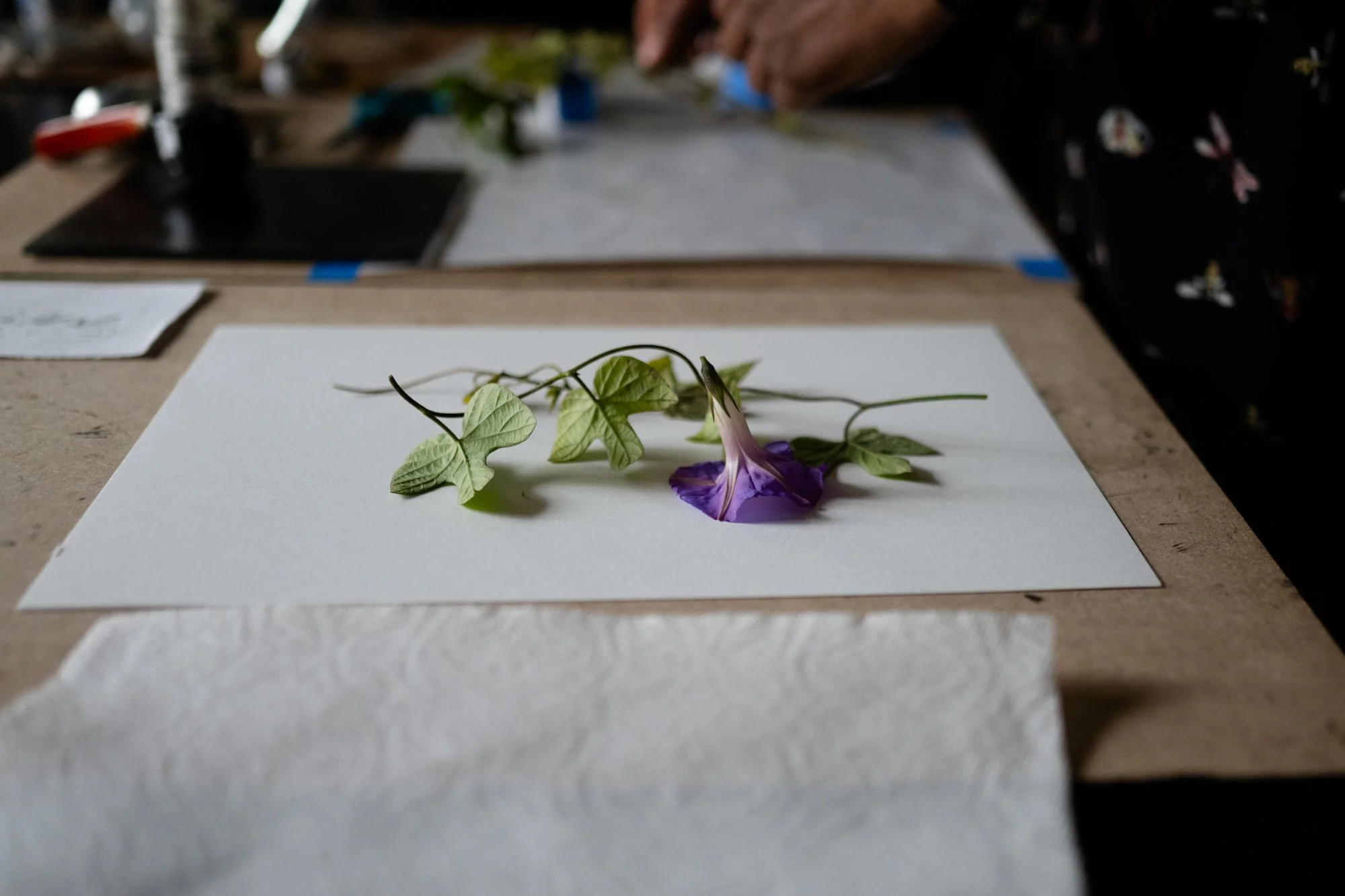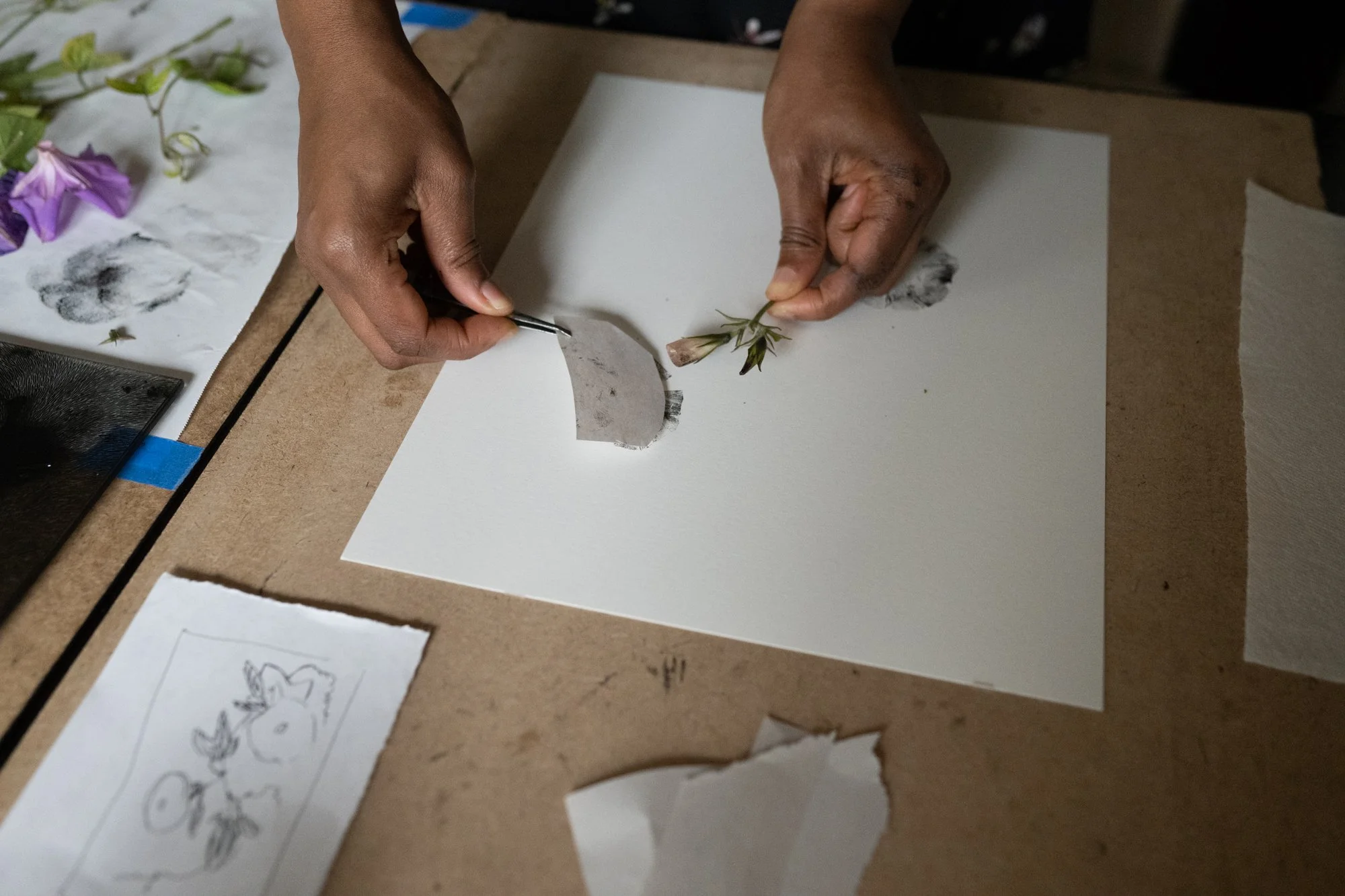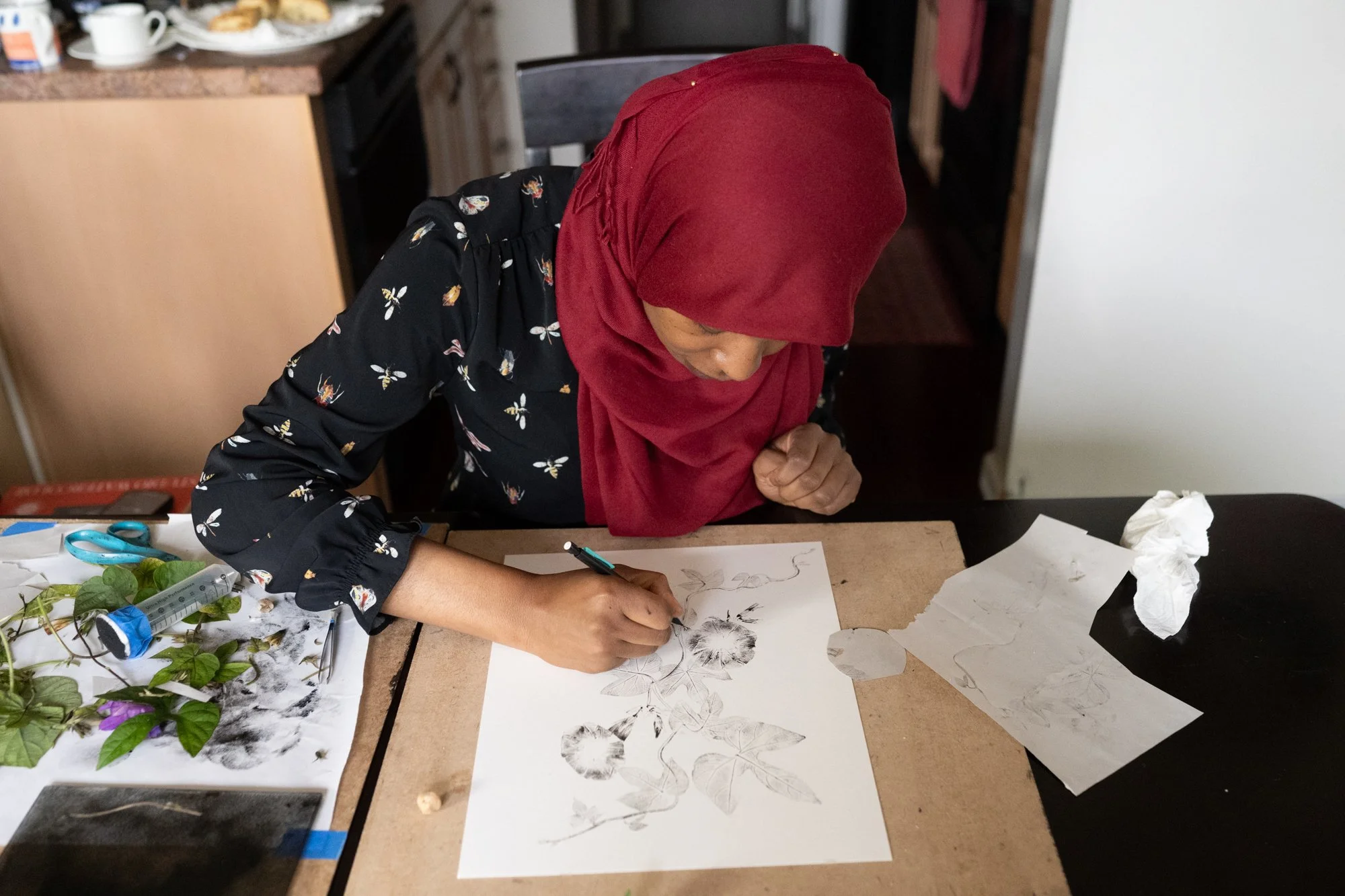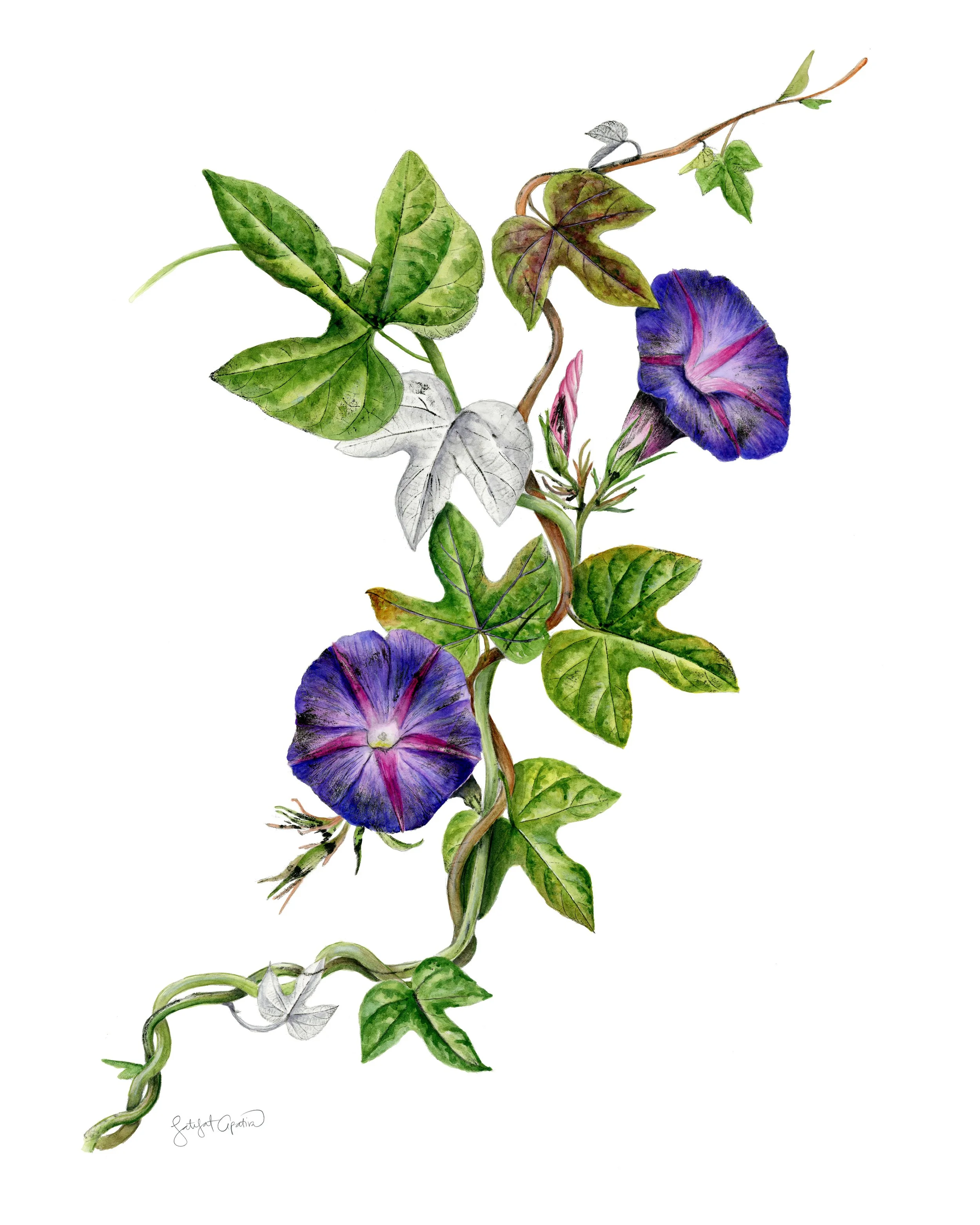Collaboration with Plants as a Remedy for Plant Blindness, Botanical Advocacy, and Olives for Palestine: A Conversation with Botanical Nature Printmaker Latifat Apatira
“There are two of us working together to create some art, the plant and I.” — Latifat Apatira
Latifat Apatira printing morning glory
Latifat Apatira is a botanical nature printmaker based in the Bay Area. As a physician who nearly became a botanist, the power of her creativity lies at the intersection of her passions and identities. Describing herself first as a Muslim-woman, this identity punctuates all the others: artist, daughter, sister, Nigerian-American, educator, plant person, and botanical activist. The many themes that make up her life’s work—faith and spirituality, the rich history of nature printing, botany, ethnobotany, and art—come together to form the whole of her creative work.
She has crafted her own approach to the ancient practice of nature printing, which has been used for centuries throughout the world for different purposes—fishermen recording their catch, physicians recording the medicinal uses of plants, and explorers and botanists documenting exotic species.
For Latifat, each nature print begins and ends with careful observation and contemplation. She sees herself in a partnership with the plant, like getting to know a new friend. The plant reveals its secrets: Intricate structures and venation not normally visible to the naked eye show up on the print.
In this interview, Latifat discusses how the life paths she did not take ended up being just as formative as the ones she did take, how her belief that she could not draw was what set her on the path to becoming the artist she is today, and her process of overcoming a phenomenon called plant blindness. Her work is botanical advocacy—she wants us to look at and to really see plants.
Most recently, Latifat turned to botanical printmaking as a way to process the grief and emotions she feels about the situation unfolding in Palestine. A feeling of “sadness set on fire” led her to create a piece titled “Olives for Palestine” where she broke new ground: free drawing an olive tree, incorporating geometric design, and including a relevant passage from the Quran. She offered prints for sale with 100% of the proceeds going to relief for the Palestinian people.
Latifat applying watercolor over to botanical print of ceanothus
This work depicting toyon is an example of one of Latifat’s latest techniques combining nature-printing and illustration. She illustrated the colorful portions with watercolor while the black and white portions are botanical prints
The artist holds a botanical nature print of buckeye. She prints the plant with ink first and then paints with watercolor
Growing Wild (GW): When did you know you wanted to be an artist, and what was your journey to becoming a botanical nature printmaker?
Latifat Apatira (LA): I wanted to be an artist when I was six years old. My art classes were always the ones that I enjoyed the most. My parents would take my brother and me to the San Francisco Botanical Garden, and I would take pictures of all the flowers, and we'd print out 35mm film at Walgreens. I loved to look at books of classical botanical art. Although I always loved them, I could never replicate them the way I wanted to. I told myself for a long time that I'm just not skilled at drawing. And that was that.
When I was younger, I was never told that I couldn't be an artist, but it was kind of understood that you're not going to make any money in art—you have to get a real job to live here. So, I did my undergrad in biology and did a lot of studies in botany. When I was at the end of undergrad, I had two thoughts in my mind—either go to medical school, or get a PhD in botany. I went to medical school. That took up a fair portion of young adult life. And I kind of forgot about art while I was in the education zone. But I joined a local garden, Filoli Historic House and Garden in Woodside, CA.
One day I saw they were offering a botanical nature-printing mixed media workshop and something inside me just clicked. I remember walking into class on the first day and having goosebumps. That workshop forever changed the course of my creative journey. Botanical art and botanical nature printing became the focus of my work. I experimented and played with the plants, the ink and the watercolor. I created botanical art that I was proud of, which was shocking to me at the time.
GW: Those moments are so few and far between in life.
LA: Printing combines a lot of things that I really enjoy. When I first took the workshop, I didn't know anything about the history of botanical nature-printing. It has a really rich history going back thousands of years. And then of course it combines plants, the arts, and creativity. All three things that I really enjoy merge together nicely.
GW: Will you talk about the centuries old monoprinting printmaking techniques, how you chose to work with those, and also how you make them your own?
LA: Monotype is a printmaking technique where you can never absolutely reproduce the same print more than once. Nature printing is a type of monotype. It is thought that the peoples of Polynesia, Tahiti in particular created botanical nature-prints on bark cloth as far back as 3,500 years ago. Japan has its own form of nature printing called Gyotaku, which is a means for fishermen to document their catches by printing fish and other sea creatures. This practice has been going on since the 1800s. In Europe going back to the 14th century, there are nature prints in museums. Apothecaries, herbalists, and explorers all used nature printing to document interesting exotic or medicinal plants.
There are many ways that people have documented plants. One way was through herbarium samples, where you take a sample of a plant, flatten it, and dry it. Another way is with botanical illustrations. Nature printing allowed for a very easy, very quick lifelike means to document plants. It became popular in Renaissance Europe. In the 1800s, it took off because new technologies for creating nature prints were developed. The most beautiful nature prints arose out of that time with extraordinary detail. Around that time, photography was developed. We became less dependent on printmaking for academic identification. Leonardo da Vinci did botanical printing, and Benjamin Franklin designed nature prints on the US dollar currency. It is interesting to join the sea of people in history using this technique.
With time and experimentation, I have picked up more complex forms. I try to figure out the geometry of how I will print it, and how I would like to create my compositions. Every new plant that I have access to and I'm able to use is a complete surprise. That's part of the excitement. If it's a new plant that I've never worked with before, let's see how this will work!
GW: You’ve said that, through your art practice, you are helping the plants to draw themselves. Why is that distinction important to you?
LA: I tell my workshop students that anybody can be a nature printer, regardless of their baseline creative or artistic abilities. With nature printing, one does not need to know how to draw because the plant draws itself. I think that's just so special. I'm not just using a plant as a subject. It is creative with me, right? It's doing a lot of the work—sharing a lot of its form, and its texture, and its secrets that I wouldn't necessarily have paid attention to or have been aware of had I not worked with that plant to create a print. It's an intimate connection. There's two of us working together to create some art, the plant and me.
GW: You’ve said you feel awe at the venation of the plants. What does that mean to you?
LA: Even in the middle of the deepest, most concrete jungle, we are still surrounded by plants. We walk by them, and there's so much detail that we would never notice, and we can't actually see with the naked eye. But with nature printing, those details are transferred onto paper. One of those details is the venation, the intricate structures within the petals, the leaves and the stem. I'm always astonished at the building blocks of these creatures that share the world with us, the intricacies of the patterns. Every single leaf is extraordinary. There are just thousands of them blowing off trees in the wind right now. And every single one is different.
GW: What can we learn from plants? What do they have to teach us?
LA: For me personally, I am a Muslim, I believe in God. Just marveling at a single leaf is a testament of God's majesty and power, and it instills in me a sense of gratitude and connectedness with the world, that nothing is created without a clear purpose. And I feel very much connected with that universal purpose when I can contemplate the leaf.
I don't necessarily think everyone has that perspective. But I do think that paying attention to plants is important overall for our survival as a species. It's only recently that study of one's local plant communities is no longer a part of mainstream education. It was a part of everybody's education until modern times.
Now there is the phenomenon called plant blindness. We have become blind to plants–-we don't acknowledge or appreciate that we all share the world together. It's really hard to think of a world where we'll preserve, maintain, or continue to work with plants when we don't even see them. There have been recent efforts to inform people that this is a problem, especially in urban Western countries. We would not be here if there were no plants. They provide all the things we need—oxygen, food, shelter and medicine. If we continue to not see them or consider them as background landscapes, instead of appreciating individual species and diversity, we are losing something in ourselves and in our futures. Nature printing gave me a new means to pay attention to plants in a way that I never really did before.
GW: Has nature printing helped you develop a more intimate connection to the actual ecosystem where you live?
LA: I am very comfortable walking through a Northern Californian environment and identifying most of the plants. I really enjoy going on hikes with people who aren't really plant people and teaching them all about the plants. I have also learned to identify a plant through its print. I found a book of black ink prints of California native plants called The Leaf Book by Ida Geary. It's so cool to flip through that book and recognize a plant because I've printed it myself and I've known the venation structures and what the leaf looks like underneath. I call that my superpower.
GW: How do you decide which plants to print?
LA: So number one is where to get the plant. Here in the United States, plants are under lock and key. Most of our open spaces and preserves have rules about not taking plants. So I make connections with gardeners and landowners who allow me to forage on their properties. I ring doorbells and drop letters in mailboxes. People will open up their whole backyards to me, and I really appreciate that.
GW: You mentioned the history of botanical printmaking, and how it was originally used to catalog plants for science and for medicine. As someone who is both a physician and a plant person, do you think about plants as medicines?
LA: One of the reasons I was so drawn to nature printing was knowing the technique was done by physicians and herbalists in the past who cared about the medicinal properties of plants and knew about their rich underlying properties that we can use for our medicines.
When I was in college, I took a medicinal ethnobotany class. It was so fascinating, the best course I took in college. I would get into class, and it would start, and I would look up at the clock, and it’s already over. Time moves so fast when you’re enjoying yourself. The instructor was Dr. Thomas Carlson. He was a physician. And he was the most enthusiastic teacher I've ever had. He is also an ethnobotanist and was my inspiration to go to med school. I wanted to be him. I wanted to be a doctor who was an ethnobotanist and treat people with medicinal plants. That's what I wanted to do.
But then I got into med school, and I really had no mentors in this area. I would share my thoughts with other people, but it was not enthusiastically received, so I didn't pursue it. I really wish I did.
One of the challenges is that, when you use an herb, you're using a whole plant. All the different phytochemicals are working with one another and interacting with one another. By contrast, in Western medicine, we take out one compound to use as a drug. There are no drugs which are whole plants or whole substances. It's really a reductionist way of looking at the world because, if you take this one compound, you think you're going to have the same effect that all the different compounds in a certain plant might have. It will take a revolution for that to change within Western medicine.
I do think now students have more opportunities to explore these ideas. Hopefully, in the future, they will be better accepted and studied because I think there's just so much potential.
GW: I want to ask about your recent piece Olives for Palestine. You wrote, “I've never felt like this before, Some call it anger. I tell them it's more like sadness set on fire.” How did the piece grow out of that? How is making art helping you to process emotions when there are no words?
“Sadness set on fire” was a statement I read on Instagram and connected with immediately because it described the intensity of the emotions I felt witnessing the destruction of Gaza. Olives for Palestine is very different from anything that I've ever done before. I've never tried to draw or print the image of a whole tree. I knew I wanted to use olives because of their significance to the Palestinian people. I had access to an olive tree, and so I took about twenty leaves. At first, I was going to print the leaves in the shape of the area of Palestine. But I just took out my pencil, and I decided to draw a tree, which is something I've never done before. And then I printed the leaves onto the branches. Most of the time when I do a print, I have a very clear composition in mind of what I am creating on the paper. But Olives for Palestine was so much more organic, in that I didn't really know what I was doing until I was doing it, and, even after the tree was done, I felt like something was still missing.
I wanted to do an Islamic geometric design on the left side of the piece. I have a Palestinian flag in my room because I've been to protests calling for a ceasefire, so I decided to use the flag. I made it into a banner so it's clearly a flag, but it's more abstract. It just came out of me. Even when that was done, I felt like something was still missing. That's when I wrote the Arabic calligraphy that means, “Sufficient is God for us And he is the best protector.” It's something I've heard the Palestinian people say on videos when they're experiencing the worst thing that has happened to them. It's a passage from the Quran that really resonated with me. No matter what people say, they're going to do what they're going to do. But God has a plan, and God's plan is amazing. Though I may not understand the wisdom behind it, I'm going to trust it. When I finally wrote that, that's when I felt the piece was complete. That's when I felt a little bit of relief from some of the anger and the frustration and sadness. I'm really proud of it,and I'm glad that I can do something to help the Palestinian people with my nature-print.
GW: I wanted to ask you about observation and contemplation, which you’ve described as an important part of your artistic process. What does that usually look like for you in practice?
LA: My goal is not hyperrealism. I do not try to exactly reproduce plants. But I want their form to come through on paper. I want someone to immediately recognize, “Oh, that is a California poppy!” To do that effectively requires a lot of observation, to really look at the form of the plant, the color, how light falls onto its botanical structure. Are the leaves coming out of the stem opposite or alternate? It makes a difference, and I might reproduce that onto the paper.
I spend a lot of time getting to know the plants that I'm working with both before and after printing them, trying to get to know them better, researching online, and with identification apps and books. If it's a new plant that I've never worked with before, it's like getting to know a new friend. And they’re added to my repertoire. And then, of course, I see it everywhere now, whenever I go out. It was always there!
GW: That's such an interesting thing about how our perception works. That there are all these mysteries right in front of us, but, until our attention is pointed to it, we don't see.
LA: In front of my parent’s townhouse was a Japanese paper plant. It's a tree bush that has these 14-inch diameter leaves, palmate, deeply lobed leaves that kind of look like a giant hand. I printed one, and my mom was like, “Wow, that leaf is beautiful, where did you get that plant from?” I was like, are you kidding? She lived there for the past 20 years and walked past it everyday, but never really noticed it. After I pointed it out, that plant became her best friend. She talks to it when she walks into the house now.
GW: When you teach workshops, what do you learn from the process of teaching others?
People are excited about becoming more friendly with plants. I tell my students the story that when I try to go on a hike, I hardly get half a mile because I'm stopping every two seconds to look at a new plant. A lot of my students tell me that their walks are taking much longer now because they're stopping to look. They see every plant that they pass now, and that just warms my heart. One individual at a time, people are paying more attention and caring. Hopefully that leads to protecting or preserving an open space or a particular plant. That will be much more likely to happen when the plant has resonance for us.
GW: Who inspires you?
My parents have gone through this transformation with me. Whenever I see a new plant, I show them, and now they know about the plant, too. It's really fun to see my parents' transformation into plant people and see them go on this nature printing journey with me. I appreciate and am inspired by them for being open and willing to learn something new.
Two prints of nasturtium. We can see the artist’s evolution to more complex printing techniques over time, on the left is a recent print while the print on the right was an early print
Slink-pod print (left) and coast redwood foliage and cones (right). Both prints were made on textured paper
Prints from this series will be on exhibit at the Point Reyes Bear Valley Visitor Center gallery later this year
Latifat with several of her large botanical prints
These two works are from a series of trees from Latifat’s garden inspired by the practice of nature-journaling and are fully illustrated. Apple (left) and lemon (right). Each page also includes a leaf print in black and white highlighted in its own section.
CREATING A MORNING GLORY BOTANICAL PRINT WITH LATIFAT APATIRA
Latifat gathering morning glory leaves and flowers from her neighborhood on a rainy morning
After removing excess water from the plant, Latifat begins to lay out her printing plan. For this piece, she created a sketch ahead of time of her vision for the final print.
Latifat rolls oil-based ink onto the pad in a thin layer using a brayer. She also mixed in a couple of drops of linseed oil to decrease the drying time of the ink.
Latifat holds the flower in preparation for adding ink. She applied the ink with a handmade ink applicator, a repurposed plastic bottle covered with a cotton pad. She tells her printmaking students that nature printing does not require a lot of specialized tools and they can get started without having to go out and buy expensive materials and tools. All they need is scissors, tape, and a little oil. A palette knife will work instead of a brayer.
Latifat cut up a few pieces of newsprint and placed them in a triangle around the flower. Next, she used her finger and pressed down all around the flower to transfer the ink to the paper
To print the second flower, Latifat uses an advanced printing technique that allows her to show the three-dimensionality of the plant. If you look at the flower from the side it appears to be an oval instead of a circle but there is no way to print it that way in a two-dimensional print. She to get her desired effect, Latifat dissects the plant, using scissors to cut the flower into and oval shape and then adding the stem in a separate step.
The completed print of Morning Glory, scanned by the artist
To learn more about Latifat’s work you can visit her website https://www.titilayola.com/ and her Instagram @titilayola

